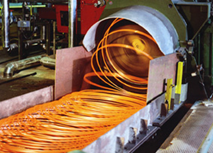The Problem
Morgan Construction Company in Worcester, Massachusetts designs and manufactures rod rolling mill equipment for steel plants. During the rolling process at the plant, each billet of hot steel increases in velocity to approximately 120 meters per second. A rotating piece of equipment incorporating a curved pipe, called the Laying Pipe, is used to change the forward velocity of the steel rod into rotational velocity. In essence, the laying pipe takes the straight rod and coils it into what resembles a super-heated slinky. Due to friction, the laying pipe wears out and must be replaced periodicially, which requires the mill to shut down production. The rolling mill operators want to maximize the life of the laying pipe, and therefore minimize costs.
Background Information
The rod rolling mills start with billets of hot steel at approximately 1000�C, which are up to 180mm square in cross section and up to 10 � 15 meters long. The steel is put through a series of rollers that gradually reduce the cross-section down to the desired product size, as small as 5mm in diameter. During the rolling process, the speed of the hot steel moving through the mill gradually increases to where it is traveling at speeds up to 120 meters per second after the last rolling stage. The rod comes out of the laying pipe in the form of a continuous helix, which can be formed into a coil once cooled for transport.
Materials Included
Seven questions (including their solutions) concerning the laying pipe:
- 2 algebra
- 1 system of equations
- 1 graph 4th order polynomials
- 2 calculus
- 1 physics


